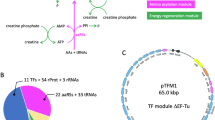Summary
A mutant strain of Eschrichia coli that is temperature-sensitive for growth stopped protein biosynthesis at 43° C after a brief lag (Fig. 1). Cell-free extracts from the strain showed no specific defect in aminoacyl-tRNA synthetases, binding initiator tRNA to ribosomes (Table 1), protein chain elongation (Tables 2, 5) or protein chain termination (Tables 3, 4) at high temperature.
The partially purified enzyme peptidyl-tRNA hydrolase, however, was temperature-sensitive (Table 6); the mutant hydrolase was inactivated rapidly at 43° C (Table 7). Mixing experiments ruled out the presence, in the mutant enzyme preparation, of an inhibitor and also demonstrated, on the mutant enzyme, a protective effect by wild type enzyme that was not shown by general coli proteins (Tables 8, 9).
Interrupted mating allowed the temperature-sensitive growth phenotype to be mapped near to and before trp (Figs. 4, 5). Co-transsduction, mediated by bacteriophage P1, with trp + (frequency 7.5%) located the marker at 24 min on the coli map. All transductants for temperature-sensitive growth also had temperature-sensitive peptidyl-tRNA hydrolase activity in crude sonicates (Table 10). We provisionally conclude that the temperature-sensitive protein synthesis and growth are caused by a single genetic change in the structural gene (pth) for peptidyl-tRNA hydrolase.
After shift to 43° C the polysomes of the mutant cells broke down into 70S particles (Figs. 2, 3). A defect in protein biosynthesis thus appeared to be located after termination and before reformation of new polysomes.
The metabolic role of peptidyl-tRNA hydrolase is discussed in the light of these experiments.
Similar content being viewed by others
References
Atherly, A. G., Menninger, J. R.: Mutant Escherichia coli strain with temperature sensitive peptidyl-transfer RNA hydrolase. Nature (Lond.) New Biol. 240, 245–246 (1972).
Atherly, A. G., Suchanek, M. C.: Characterization of mutants of Escherichia coli temperaturesensitive for ribonucleic acid regulation: An unusual phenotype associated with a phenyalanyl transfer ribonucleic acid synthetase mutant. J. Bact. 108, 627–638 (1971).
Bretscher, M.: Asymmetrical lipid bilayer structure for biological membranes. Nature (Lond.) New Biol. 236, 11–12 (1972).
Betscher, M., Goodman, H., Menninger, J., Smith, J.: Polypeptide chain termination using synthetic polynucleotides. J. molec. Biol. 14, 634–639 (1965).
Capecchi, M. R.: A rapid assay for polypeptide chain termination. Biochem. biophys. Res. Commun. 28, 773–778 (1967).
Chapeville, F., Yot, P., Paulin, D.: Enzymatic hydrolysis of N-acyl-aminoacyl tRNAs. Cold Spr. Harb. Symp. quant. Biol. 34, 493–498 (1969).
Cuzin, F., Kretchmer, N., Greenberg, R. E., Hurwitz, R., Chapeville, F.: Enzymatic hydrolysis of N-substituted aminoacyl-tRNA. Proc. nat. Acad. Sci. (Wash.) 58, 2079–2086 (1967).
Davis, J. E., Sinsheimer, R. L.: The replication of bacteriophage MS2 1. Transfer of parental nucleic acid to progeny phage. J. molec. Biol. 6, 203–207 (1963).
Flessel, C. P., Ralph, P., Rich, A.: Polyribosomes of growing bacteria. Science 158, 658–660 (1967).
Guerola, N., Ingraham, J. L., Cerdá-Olmedo, E.: Induction of closely linked multiple mutations by nitrosoguanidine. Nature (Lond.) New Biol. 230, 122–125 (1971).
Gurgo, C., Craig, E., Schlessinger, D., Afolayan, A.: Polyribosome metabolism in Escherichia coli starved for an amino acid. J. molec. Biol. 62, 525–535 (1971).
Kaplan, S.: Correlation between the rate of ribonucleic acid synthesis and the level of valyl transfer ribonucleic acid in mutants of Escherichia coli. J. Bact. 98, 579–586 (1969).
Kössel, H.: Purification and properties of peptidyl-tRNA hydrolase from Escherichia coli. Biochim. biophys. Acta (Amst.) 204, 191–202 (1970).
Kössel, H., RajBhandary, U. L.: Studies on polynucleotides: LXXVI. Enzymic hydrolysis of N-acyl-aminoacyl-transfer RNA. J. molec. Biol. 35, 539–560 (1968).
Lapidot, Y., de Groot, N.: The chemical synthesis and the biochemical properties of peptidyl-tRNA. Progress in nucleic acid research and molecular biology, vol. 12, p. 189–228, eds. Davidson, J. N., and Cohn, W. E.: New York: Academic Press 1972.
Matthaei, J. H., Nirenberg, M. W.: Characteristics and stabilization of DNAase-sensitive protein synthesis in Escherichia coli extracts. Proc. nat. Acad. Sci. (Wash.) 47, 1580–1588 (1961).
Menninger, J. R.: A simple assay for protein chain termination using natural peptidyl-tRNA. Biochim. biophys. Acta (Amst.) 240, 237–243 (1971).
Menninger, J. R., Mulholland, M. C., Stirewalt, W. S.: Peptidyl-tRNA hydrolase and protein chain termination. Biochim. biophys. Acta (Amst.) 217, 496–511 (1970).
Menninger, J. R., Walker, C.: An assay for protein chain termination using peptidyl-tRNA. In: Methods in enzymology, nucleic acids and protein synthesis, vol. XX, part E (1973) (in the press).
Pestka, S.: Inhibitors of ribosome functions. Ann. Rev. Microbiol. 25, 487–462 (1971).
Phillips, S. L., Schlessinger, D., Apirion, D.: Mutants in Escherichia coli ribosomes: A new selection. Proc. nat. Acad. Sci. (Wash.) 62, 772–777 (1969)
Sabol, S., Antonia, M., Sillero, G., Iwasaki, K., Ochoa, S.: Purification and properties of initiation factor F3. Nature (Lond.) 228, 1269–1273 (1970).
Schlessinger, D.: Ribosomes: Development of some current ideas. Bact. Rev. 33, 445–453 (1969).
Siegelman, F., Apirion, D.: Aurintricarboxylic acid, a preferential inhibitor of initiation of protein synthesis. J. Bact. 105, 902–907 (1971).
Stanley, Jr., W. M., Bock, R. M.: Isolation and physical properties of the ribosomal ribonucleic acid of Escherichia coli. Biochemistry 4, 1302–1311 (1965).
Subramanian, A. R., Davis, B. D.: Activity of initiation factor F3 in dissociating Escherichia coli ribosomes. Nature (Lond.) 228, 1273–1275 (1970).
Taylor, A. L.: Current linkage map of Escherichia coli. Bact. Rev. 34, 155–175 (1970).
Taylor, A. L., Trotter, C. D.: Revised linkage map of Escherichia coli Bact. Rev. 31, 332–353 (1967).
Vogel, Z., Zamir, A., Elson, D.: On the specificity and stability of an enzyme that hydrolyzes N-substituted aminoacyl-transfer RNA's. Proc. nat. Acad. Sci. (Wash.) 61, 701–707 (1968).
Webster, R. E., Engelhardt, D. L., Zinder, N. D.: Amber mutants and chain termination in vitro. J. molec. Biol. 29, 27–43 (1967).
Author information
Authors and Affiliations
Additional information
Communicated by M. Nomura
Journal paper No. J-7465 of the Iowa Agriculture and Home Economics Experiment Station, Ames, Iowa, project no. 1747.
Rights and permissions
About this article
Cite this article
Menninger, J.R., Walker, C., Tan, P.F. et al. Studies on the metabolic role of peptidyl-tRNA hydrolase. Molec. Gen. Genet. 121, 307–324 (1973). https://doi.org/10.1007/BF00433230
Received:
Issue Date:
DOI: https://doi.org/10.1007/BF00433230




